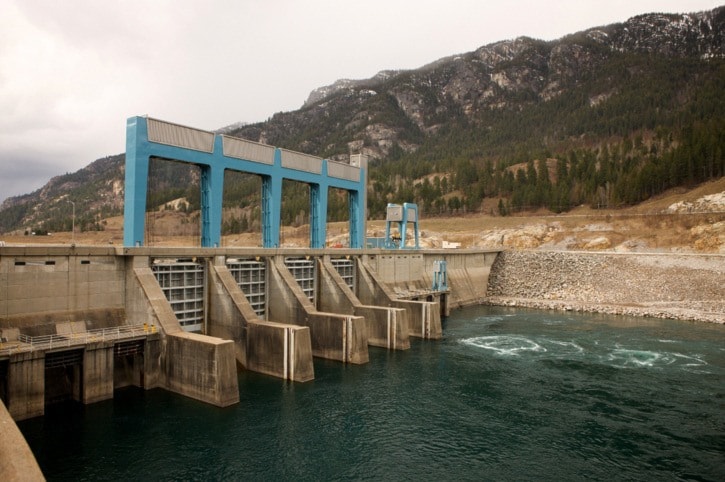Ten Nakusp residents trickled in to the BC Hydro operations update meeting on Wednesday, June 13 where Hydro reps Mary Anne Coules, Gillian Kong and James Stark filled them in on what has been happening at the utility over the past year.
The year was framed as a “regeneration phase” for BC Hydro whose aging facilities need investment, said Coules.
In the last six years, Hydro performed an “equipment health reading,” which, in light of new inspection standards, changed the value of the corporation’s aging assets. BC Hydro found it had a lot of old equipment that was suddenly worth less according to the new standards, prompting the recent push for upgrades.
Smart meters were named as another part of the phase, which the rep said will bring B.C. up to speed with the rest of the world, 90 per cent of which will be using the meters by 2020, according to BC Hydro.
The reps fielded a number of questions about the new meters. One resident asked about reports that people who had taken on test meters and seen their power costs go up. Coules replied that although there was one case in Duncan of a meter giving false readings that resulted in higher bills, generally bill increases were attributed to other factors.
“Most calls about higher bills are from people who don’t have smart meters,” said Coules.
Will there be a move to time of use billing with the introduction of the new meters, asked another Nakuspian, who was told no, there wouldn’t be.
Why was there such a large discrepancy in the cost per meter in Ontario versus B.C., with our meters costing so much more, another person asked. Coules replied that it was because the Ontario figure was the price of the meter alone, while the B.C. rate included the infrastructure cost as well per meter.
Another part of BC Hydro’s “regeneration” plan is the development of Site C, a potential third dam in the Peace region, which was explained as possibly being necessary to meet the increasing energy needs of the province.
Site C was cited as the answer to one person’s question about Independent Power Producers. “Shouldn’t we use existing dams first rather than messing up more streams?” he asked.
“Absolutely,” replied Coules, who said that was why upgrades to Revelstoke and Site C were being planned.
Upgrades to local Hydro projects will include work on the Hugh Keenleyside Dam and the Duncan Dam, with the repairs to both to cost in the neighbourhood of $130 million.
How are all these projects being paid for, asked one audience member, and Stark replied that BC Hydro was currently conducting a rate review for that very reason.
“BC Hydro is still charging the lowest rates in North America,” contributed Coules.
The Fish and Wildlife Compensation Program will have a new delivery model soon, said Coules. The FWCP saw major changes last year when 30 per cent of BC Hydro’s environment staff was cut. Many of the Hydro staff also worked as part of the FWCP. Now, Coules said, many of those former staff members are on a recall list for work with the FWCP. Hydro hopes to retain the legacy knowledge of those staff members by keeping them on the list, although the work is now given out via contracts.
Coules also let everyone in the room know that BC Hydro has handed Nakusp’s Reservoir Boat Ramps project over to Columbia Power Corporation.
There were a few questions about the ramps, particularly what water levels they were going to be built for. More than one voice in the room brought up the Burton ramp and how it wasn’t sufficient for the low water levels in winter, when many locals go fishing. Coules said that Hydro was aware of the problem in Burton and was going to extend it “as soon as possible.”
The Hydro rep said the design for the Nakusp ramp was similar to the one developed two years ago, and that people interested in giving their input to the project should get in contact with Audrey Repin at Columbia Power.
There has been a lot of debris floating in the lake this year, and Hydro has already spent $90,000 on debris removal this spring. More is to come this year, to the tune of $60,000. Avid swimmers look forward to not hauling out pounds of flotsam and jetsam caught in their hair this summer.
Gillian Kong then took up the reins with the “Systems Summary.” First off was the discussion of the higher-than-normal snow pack in the Basin this year and last. Levels are 12 per cent above normal, which has predictions being made that the storage reservoirs will fill and even possibly spill in 2012. What this means is that it’s likely BC Hydro will have a net selling year again.
In terms of the water supply forecast, the Arrow Reservoir is at 112 per cent of normal. This was the lowest forecast, with Duncan and Kootenay at the highest with 120 per cent forecast.
Even with all that water projected to be coming down the mountains and all the rain falling from the sky recently, maintaining good water levels for recreational uses might be difficult this year, said Kong. Two of four units at Mica will likely be out of service until the end of August, and unless the rain keeps coming, the Arrow water level won’t be maintained. But, there are two months of weather in the meantime, said Kong, and if it’s a wet summer, well, at least the lake levels will be high.
After all was said and done, Kong said she was impressed by the participants that had come out that evening.
“They asked really intelligent questions,” she said, and kept the presentation interesting for her as well.
